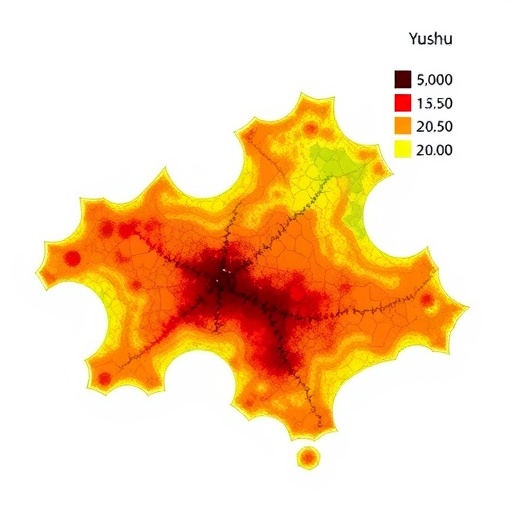In an era where environmental health is becoming increasingly critical, the latest research from a team of scientists has delved into the complex realm of soil contamination in Yushu City, located in Qinghai Province, China. This groundbreaking study, titled “Multiple fractal characterization for elemental soil contamination,” introduces an innovative approach to understanding the spatial distribution and characteristics of elemental contaminants in the soil. The researchers, led by Zhang et al., harnessed advanced fractal geometry techniques to provide new insights and interpretations regarding the contamination of the soil in this mountainous and ecologically rich region.
One of the main objectives of the study is the assessment of elemental contaminants in Yushu’s soil, including toxic heavy metals that pose threats to human health and the environment. The research highlights the pressing need for reliable methodologies in environmental monitoring, especially in regions where industrial activities and urbanization might lead to elevated levels of soil contamination. By applying a fractal characterization approach, the researchers aim to address the key challenges in measuring and modeling soil contamination patterns.
Fractal analysis is not a common method in environmental science, but Zhang and his colleagues argue for its potential in depicting complex geographical phenomena efficiently. By revealing the multifaceted nature of soil contaminants through a fractal lens, the team’s analysis affords environmental scientists a more nuanced tool in assessing pollution patterns. This novel framework enables a deeper understanding of how pollutant distribution may vary across diverse landscapes, providing a significant leap forward in their studies of soil health and safety.
In Yushu City, the diverse geological compositions and varying land uses contribute to the sporadic presence of elemental contaminants across different regions. The study harnesses high-resolution soil sampling data collected from various sites across the city, including urban areas and agricultural zones. This data not only aids in identifying contaminant hotspots but also provides a comprehensive overview of how human activities influence elemental distribution in the local ecosystem. With the increasing pace of urban development in Yushu, understanding these layers of contamination becomes paramount.
The researchers utilized multiple fractal dimensions to characterize the spatial distribution of contaminants, revealing significant insights into how these substances aggregate and disperse in the soil. This multifaceted approach sheds light on the complex interplay between anthropogenic activities, natural processes, and the broader environment. Fractal analysis allows scientists to model the distribution of contaminants through various scales, offering a glimpse into how such pollution might evolve with changing land-use patterns over time.
Zhang et al.’s findings indicate that specific areas of Yushu exhibit significantly heightened levels of soil contamination, prompting serious concerns about environmental and public health in the region. The presence of heavy metals such as lead, cadmium, and arsenic was notably high in certain sampled areas, suggesting that industrial and agricultural practices may exacerbate the introduction of these hazardous elements into the soil. This discovery could potentially have far-reaching implications for agricultural productivity and public health in Yushu.
Moreover, the research has broader implications for environmental policy and urban planning. As cities expand and develop, the findings underscore the necessity for stringent monitoring and management strategies that address the root causes of soil contamination. By understanding the fractal nature of soil pollutants, policymakers can devise more effective strategies to mitigate risks to public health and the environment.
In light of this investigation, future research could pivot towards the temporal aspects of soil contamination, exploring how pollutants evolve or dissipate over time. Longitudinal studies that track changes in soil quality, alongside ongoing fractal analyses, would be essential to understanding the lifecycle of elemental contaminants. This step would not only enrich the scientific discourse but would also arm local authorities with vital information to make informed decisions regarding land use and pollution control measures.
As the research garners attention, it emphasizes the relevance of interdisciplinary approaches in addressing environmental challenges. By merging geology, ecology, and mathematics, the researchers offer a holistic view of soil contamination—one that encourages a broader dialogue among scientists, policymakers, and community stakeholders. This interdisciplinary model serves as a template for future studies across different environmental contexts, suggesting a universal application of fractal analysis in environmental assessments.
In conclusion, the work by Zhang et al. presents a paradigm shift in how soil contamination is studied and characterized, particularly through the lens of fractal geometry. This innovative framework has the potential to reshape current methodologies in environmental sciences, paving the way for more sophisticated models that can account for the complexities of pollutants and their interactions with ecosystems. The significance of this work extends beyond Yushu City, promoting a more nuanced understanding of soil health and environmental sustainability globally.
The implications of this study are already resonating in the scientific community, potentially inspiring a new wave of research that continues to innovate in the field of environmental monitoring. As society becomes more aware of the impacts of pollution, studies like these are essential in framing the conversations around soil quality, land use policy, and community health. The road ahead for soil science is promising, guided by the pioneering work of Zhang and his colleagues.
With the findings published in the “Environmental Monitoring and Assessment,” there is tangible excitement surrounding the potential applications of this research. As scientific curiosity continues to drive investigations into soil contamination, combining innovative analytical methods like fractal characterization with traditional environmental science can only enhance our understanding and stewardship of the Earth’s resources. The future of sustainable agriculture, urban planning, and environmental health now rests on transforming how we perceive and measure environmental contaminants in our world.
Subject of Research: Elemental soil contamination in Yushu City, Qinghai Province, China.
Article Title: Multiple fractal characterization for elemental soil contamination across Yushu City, Qinghai Province, China.
Article References:
Zhang, H., Zhang, Y., Liu, Q. et al. Multiple fractal characterization for elemental soil contamination across Yushu City, Qinghai Province, China. Environ Monit Assess 197, 1007 (2025). https://doi.org/10.1007/s10661-025-14467-8
Image Credits: AI Generated
DOI:
Keywords: Soil contamination, Fractal analysis, Environmental monitoring, Heavy metals, Yushu City, Public health, Interdisciplinary research, Environmental policy.




